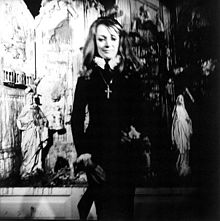
Back Niki de Saint Phalle ALS نيكي دي سانت فال Arabic نيكى دى سانت فال ARZ Niki de Saint Phalle BAR Niki de Saint-Phalle BS Niki de Saint Phalle Catalan Niki de Saint Phalle Czech Niki de Saint Phalle Welsh Niki de Saint Phalle Danish Niki de Saint Phalle German
Niki de Saint Phalle | |
|---|---|
 1970 portrait by Lothar Wolleh | |
| Born | Catherine Marie-Agnès Fal de Saint Phalle[1] 29 October 1930 Neuilly-sur-Seine, Hauts-de-Seine, France |
| Died | 21 May 2002 (aged 71) |
| Nationality | French, American, Swiss[2] |
| Education | Self-taught in art[3] |
| Known for | Sculpture, painting, filmmaking |
| Notable work | Nanas Tarot Garden |
| Style | Nouveau réalisme, Feminist art |
| Spouse(s) |
[4] |
| Awards | Prix Caran d’Ache (1994) Praemium Imperiale (2000) |
| Patron(s) | Agnelli family |
| Website | nikidesaintphalle |
Niki de Saint Phalle (French: [niki d(ə) sɛ̃ fal]; born Catherine Marie-Agnès Fal de Saint Phalle;[1] 29 October 1930 – 21 May 2002) was a French-American[5][6] sculptor, painter, filmmaker, and author of colorful hand-illustrated books. Widely noted as one of the few female monumental sculptors,[7] Saint Phalle was also known for her social commitment and work.[8][9]
She had a difficult and traumatic childhood and a much-disrupted education, which she wrote about many decades later. After an early marriage and two children, she began creating art in a naïve, experimental style. She first received worldwide attention for angry, violent assemblages which had been shot by firearms. These evolved into Nanas, light-hearted, whimsical, colorful, large-scale sculptures of animals, monsters, and female figures. Her most comprehensive work was the Tarot Garden, a large sculpture garden containing numerous works ranging up to house-sized creations.
Saint Phalle's idiosyncratic style has been called "outsider art"; she had no formal training in art,[3] but associated freely with many other contemporary artists, writers, and composers.[10] Her books and abundant correspondence were written and brightly-colored in a childish style, but throughout her lifetime she addressed many controversial and important global problems in the bold way which children often question and call out unacceptable neglect.[9]
Throughout her creative career, she collaborated with other well-known artists such as Jasper Johns, Robert Rauschenberg, Larry Rivers, composer John Cage, and architect Mario Botta, as well as dozens of less-known artists and craftspersons. For several decades, she worked especially closely with Swiss kinetic artist Jean Tinguely, who also became her second husband. In her later years, she suffered from multiple chronic health problems attributed to repeated exposure to airborne glass fibers and petrochemical fumes from the experimental materials she had used in her pioneering artworks, but she continued to create prolifically until the end of her life.
A critic has observed that Saint Phalle's "insistence on exuberance, emotion and sensuality, her pursuit of the figurative and her bold use of color have not endeared her to everyone in a minimalist age".[11] She was well known in Europe,[11] but her work was little-seen in the US, until her final years in San Diego. Another critic said: "The French-born, American-raised artist is one of the most significant female and feminist artists of the 20th century, and one of the few to receive recognition in the male-dominated art world during her lifetime".[12]
- ^ a b Cite error: The named reference
LW1930-49was invoked but never defined (see the help page). - ^ "40 years of Niki's nanas". SWI swissinfo.ch. Swiss Broadcasting Corporation SRG SSR. 27 October 2005. Retrieved 2021-06-03.
- ^ a b Neal, Jane (26 Feb 2008). "Niki de Saint Phalle: The power of playfulness". Telegraph. Retrieved 2017-04-18.
- ^ "January 2017 – Niki Charitable Art Foundation". Niki Charitable Art Foundation. Retrieved 2017-04-13.
- ^ "Video Clips". Niki Charitable Art Foundation. Niki Charitable Art Foundation (NCAF). Retrieved 2017-04-18.
- ^ Cite error: The named reference
GP-Brochurewas invoked but never defined (see the help page). - ^ Cite error: The named reference
Muchnicwas invoked but never defined (see the help page). - ^ Christiane., Weidemann (2008). 50 women artists you should know. Larass, Petra., Klier, Melanie, 1970–. Munich: Prestel. ISBN 978-3-7913-3956-6. OCLC 195744889.
- ^ a b Sluiter, Johanna (2021-04-11). "Niki de Saint Phalle's Vibrant, Multidimensional Universe". Hyperallergic. Retrieved 2021-06-11.
- ^ Cite error: The named reference
Robbwas invoked but never defined (see the help page). - ^ a b Cohen, Roger (7 October 1993). "At Home With: Niki de Saint Phalle; An Artist, Her Monsters, Her Two Worlds". The New York Times. Retrieved 2017-04-22.
- ^ Jansen, Charlotte (12 July 2016). "The Art of Niki de Saint Phalle: A Rebel Through and Through". Huffington Post. Retrieved 2017-04-22.